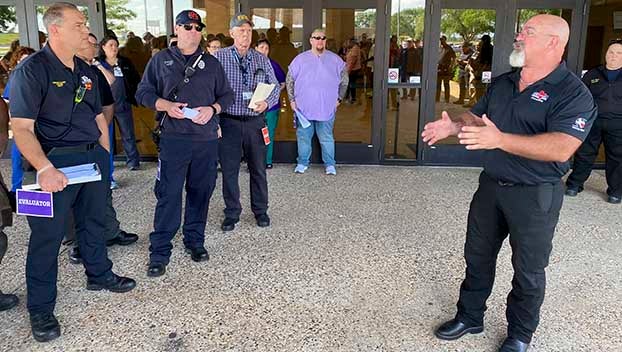PHOTO GALLERY — “We have to communicate.” Local 1st responders train on keys to mass emergency response.
Published 4:14 pm Tuesday, April 11, 2023





|
Getting your Trinity Audio player ready...
|
It took only seconds for members of the Port Arthur Police Department SWAT team to rush into the Robert A. “Bob” Bowers Civic Center Tuesday morning and begin securing hallways before entering the area of an active shooting drill.
It was the first of three mass casualty incident scenarios that first responders from all across Southeast Texas participated in.
The situation was not real. The possibility is.
Trending
“We have to communicate,” said Southeast Texas Regional Advisory Council Emergency Management Coordinator Jeremy Way. “If we don’t communicate, we are not going to be as effective as we need to be. And unfortunately in our line of business, that means people are going to die. It’s not a game — no shaking hands, going back tomorrow and doing it again.”
The eight-hour training event was organized by the SETRAC, the Port Arthur Fire Department and Christus Southeast Texas. It was open to all police, firefighters, EMTs, nurses and emergency managers. Representatives from area police and fire departments, refineries, hospitals and other agencies were among the large crowd in attendance.
And while the first drill involved a mass shooting, Port Arthur Fire Chief Greg Benson said a mass casualty incident spreads far beyond that.
“A mass casualty incident can happen in any scenario,” he said. “It could be a bus that gets t-boned by a truck.”
Explosions and storms were other examples.
Tuesday morning began with an hour-long presentation to bring all participants together with protocol. Although that, Benson said, isn’t always the same.
Trending
“You have to be flexible when you’re dealing with these,” he said.
After the first group of armed officers entered the room, the “shooter” was identified and the area of activity was cleared.
“That’s then when you start doing triage,” Benson said. “You have to triage people based on severity. And then you put them into one of four categories: black, which means they’re dead; red is the highest priority; yellow is second priority and green is last.”
EMTs wearing brightly colored ballistic helmets and vests that were clearly labeled then entered the room and brought the patients to the Casualty Collection Point, where treatment begins and transportation is arranged.
Of the multiple victims, some spoke to first responders. Some cried out for help. And some were clearly marked “dead.”
“The reason we leave the dead where they’re at is because it’s a crime scene, too. There’s nothing we can do for them unfortunately, so it becomes part of the investigation,” Benson said.
Following the mock drill, everyone gathered outside to assess what went right and what could have gone better.
Clear communication was the focal point.
“When we communicate things like this on a (mass casualty incident) scene, we’ve got to make sure we’re communicating to everybody,” Way said. “Everybody has to be on the same page. If everybody doesn’t realize we have a mass casualty incident working, especially with an active attack — resources are coming. People are coming. We have to be on the same page.”
Benson said similar training sessions will be done annually.











